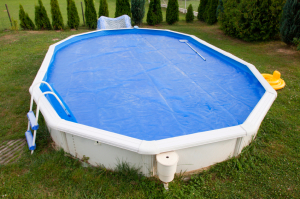It’s hard, sad, terrible, all other kinds of synonyms, to acknowledge when the weather starts to get a little cooler, the sun starts to set a little earlier, and the lazy days of summer are gone again. And while homeowners hate to say goodbye to those easygoing, sun-drenched hours spent lounging by the swimming pool, you need to get your pool ready for the snow and ice if you want to be able to enjoy it again without dumping your savings into repair work next spring.
It’s got to be done, and for those of you who are new to pool ownership or unsure of how exactly to hibernate your pool, here’s what you need to do when shutting down your above or in-ground pool.
An Above Ground Pool
Start by making sure the water chemistry of the pool is balanced. Check your pH, Total  Alkalinity, and Calcium Hardness so the pool liner where the surface of the water sits is well-protected from staining and etching.
Alkalinity, and Calcium Hardness so the pool liner where the surface of the water sits is well-protected from staining and etching.
A floater with a strong oxidizer like chlorine or bromine could stain or bleach the wall. So don’t use one! You should also avoid throwing chlorine or bromine tablets into the water because they’ll damage the liner surface just like the floater would.
Lower the water level below the mouth of the skimmer or using an Aquador on the mouth of the skimmer. Or do things the old way with a bucket and some muscle power. Pro tip: enlist some friends.
Drain all the water from the filter equipment and hoses run the pump for a few seconds to remove water from the veins of the impeller. DO NOT do this for more than a second or two, or risk burning out the seal.
Let the chemicals run out of the chemical feeder so they’re not damaged over the winter months. Once that’s done you can drain the chemical feeder.
Finally, cover your pool up for the winter with a good quality cover to protect it from debris.
Once all these steps are done, you should also put the pump and pressure gauge inside for the winter. Don’t risk the cold weather damaging either.
Winterizing Your In-Ground Pool
Like an above-ground pool, your in-ground pool needs balanced water chemistry to sit  throughout the winter, so check your pH, Total Alkalinity and Calcium Hardness. Don’t use floaters with strong oxidizers and don’t dump bromine or chlorine tablets into the standing water. Lower the water level below the mouth of the skimmer so frozen water doesn’t crack and ruin its innards.
throughout the winter, so check your pH, Total Alkalinity and Calcium Hardness. Don’t use floaters with strong oxidizers and don’t dump bromine or chlorine tablets into the standing water. Lower the water level below the mouth of the skimmer so frozen water doesn’t crack and ruin its innards.
Blow out the water from your plumbing lines, adding a plug in the lines at the pool end as the water is removed from each one. A plug with a rubber gasket or “O” ring will ensure the lines are totally sealed. You can use a rubber freeze plug for any unthreaded fittings.
Use a cover to keep debris out for the winter. There are both hard and soft covers. If you worry about animals or kids falling into the winterized pool, opt for a more expensive hard cover. After that, the final step is to drain the water from the filter equipment.
Winterizing your pool is a chore for certain, made a little worse by the fact that swimming season is over and cold weather is on its way, but doing it right will make sure you have a functional pool to swim in next year.
If you want to make your pool area look more like a retreat next year, give us a call to find out how we can get started today.
Interested in turning your backyard into a Pool Oasis? Request a Landscaping Quote »


